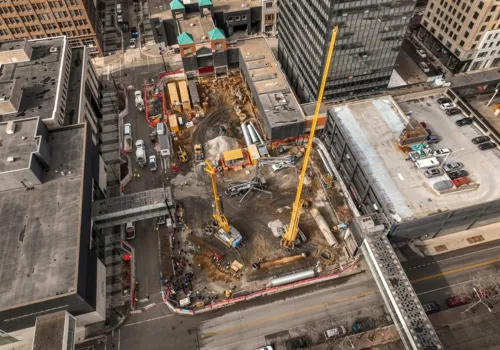
The 515 Walnut Tower is now under construction in downtown Des Moines, Iowa, promising to reshape the city’s skyline and meet growing housing needs. With an estimated cost of $148 million and a projected completion date in 2027, the 33-story structure will be the tallest residential building ever constructed in the city.
The development will introduce 390 new residential units, 39 of which will include affordability restrictions, as well as extensive amenities such as a rooftop pool, coworking spaces, a dog park, and direct access to downtown amenities.

“This project helps address the growing demand for housing in downtown Des Moines to accommodate our growing population and workforce,” said Carrie Kruse, the city’s economic development administrator. “Supporting housing projects like this is crucial for maintaining housing affordability and supporting the city's continued economic growth.”
The tower is rising on the site of the former Kaleidoscope Mall, demolished in 2023. It will be the first major addition to the city’s skyline since the EMC Insurance building was completed in 1996.
“This transformational project will attract new residents and businesses, fostering further economic development opportunities,” Kruse added. “It will complement the city's growing housing and employment demands.”
More than 700 construction jobs will be created during the build. The project is being led by Beal Derkenne Construction, with Andy Beal noting the logistical complexity.
“There’s an immense amount of pre-planning, coordination and communication that goes into the day-to-day activities,” Beal said. “With any postage stamp-sized site, movement around the site is very precise and exact.”

The tower’s footprint consumes nearly the entire site, limiting space for materials and staging. Crews have removed over 7,000 yards of earth to accommodate deep and shallow foundation systems. During drilling, they encountered remnants of early 20th-century buildings, forcing delays.
“We unearthed some unique reinforcing steel that dated back to that era, approximately 18 to 30 feet below grade,” said Beal. “This slowed the drilling operation, as we were forced to drill through the steel and concrete elements.”
Construction began in winter 2024, with mild weather helping minimize delays. Tower cranes and massive mobile rigs have since been brought in, and vertical construction is about to begin.
Beal emphasized the project's impact:
“It’s fun to be able to lead and execute one of these in our own backyard… It will become the tallest building built in Des Moines this century, and the fourth tallest in Iowa.”
Kruse praised the project’s broader significance.
“The construction of 515 Walnut Tower is a momentous occasion for Des Moines, symbolizing the city’s dynamic growth, our community’s resilience and forward-looking vision,” she said.
The tower will feature post-tensioned concrete slabs and a sleek glass façade with integrated metal louvers. It also plays a critical role in reconnecting Des Moines’ downtown skywalk system, improving pedestrian flow between key commercial, residential, and public spaces.
In addition to creating hundreds of jobs, the project is expected to boost nearby businesses, suppliers, and services. Kruse noted that “projects like this contribute to the vibrancy and lively urban atmosphere… which has a multiplier of spin-off economic impacts.”
The tower’s location offers residents proximity to parks, restaurants, public transit, trails, and employers. Its placement helps maximize downtown density and is aligned with city revitalization goals.
With construction now well underway, the tower is poised to become a beacon of Des Moines’ growth and ambition. As the structure rises, it will not only add housing, but signal a new era of urban living in Iowa’s capital.
Originally reported by Cindy Riley in Construction Equipment Guide.